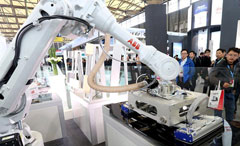Reform makes China’s economy stronger, greener
2017-07-19
Xinhua
BEIJING — Thanks to ongoing supply-side structural reform, China’s economy has firmed up in the first half of the year, boosting green development, according to the country’s top economic planner.
“Supply-side structural reform is creating positive effects for economic growth. The interaction of supply and demand in markets has improved significantly in the first six months,” said Yan Pengcheng, spokesperson with the National Development and Reform Commission, at a news conference on July 18.
China on July 17 reported a faster-than-expected 6.9 percent growth in the first half of the year, setting the country on course to comfortably meet its 2017 growth target.
SUSTAINED GROWTH
In the first half, the efficiencies of industrial enterprises increased rapidly, said Yan.
Profits of large industrial enterprises increased 22.7 percent year on year in the first five months, with particularly robust growth in May of 16.7 percent, according to Yan.
The official manufacturing PMI rose to 51.7 in June, accelerating from 51.2 in May, marking a three-month high. June’s official non-manufacturing PMI also improved for the second month in a row to 54.9, from 54.5 in May, providing evidence of a better economic structure.
China has been trying to shift its economy toward a growth model that draws strength from consumption, services, and innovation.
The nationwide overcapacity reduction campaign has helped improve the performance of major industries, with impressive progress in the steel and coal sectors, Yan said.
During the first half, substandard steel production capacity was removed and the newly increased capacity was strictly controlled. About 111 million tonnes of outdated capacity was forced out of the market, completing 74 percent of the annual target.
“As a large number of zombie companies withdraw from the market, major industry players will have a bigger role in allocating resources and planning production, which further improves their business performance and market expectations,” said Yan.
While excessive capacity is eliminated, new growth drivers are gaining momentum. Consumption and services, together with innovation-driven new economic sectors, are playing a larger role in the economy, according to official data.
The service sector, which already accounts for 54.1 percent of the overall economy, expanded 7.7 percent year on year in the first half, outpacing a 3.5-percent increase in primary industries and 6.4 percent in secondary industries.
In the first half, the contribution of final consumption to GDP growth stood at 63.4 percent, slightly down from 64.6 percent for 2016. About 2.9 million new companies were established nationwide, up 11.1 percent from a year earlier.
GREEN DEVELOPMENT
Clean energy has accounted for 27.2 percent of the country’s total power output in the first six months, up 1.8 percentage points from the same period last year, Yan said.
The amount of electricity generated from clean energy sources has increased by 5.15 percent year on year, equivalent to a 22-million-tonne reduction in thermal coal consumption, according to Yan.
Wind power generated in the Jan-June period grew 25.7 percent year on year, while solar power jumped 80.3 percent and nuclear power was up 20.8 percent, he said.
Yan said he expects a further rise in clean power output in the coming months when the country’s electricity consumption braces for its seasonal peak, due to a potential increase in hydropower output during the flood season and a pick-up in wind and solar power development.
He predicted that up to 30 percent of China’s total power output this summer will be clean power, which will help reduce thermal power generation by nearly 40 billion kWh and thermal coal consumption by some 18 million tons between July and September.
China’s power output increased 6.3 percent year on year to 2.96 trillion kilowatt-hours in the first half of 2017, official figures showed.
The country has pledged to cut its carbon emissions per unit of GDP by 60-65 percent from 2005 levels by 2030 and raise the share of non-fossil energy use in total consumption to about 20 percent.


